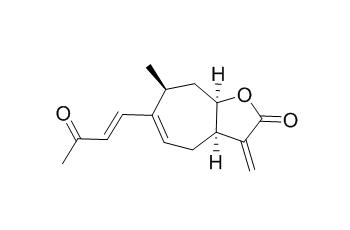8-Epixanthatin
8-Epixanthatin, a light-induced growth inhibitor, mediates the phototropic curvature in sunflower (Helianthus annuus) hypocotyls, it can induce germination of O. cumana at nano- to micromolar concentrations. 8-Epixanthatin has antiprotozoal activity.
Inquire / Order:
manager@chemfaces.com
Technical Inquiries:
service@chemfaces.com
Tel:
+86-27-84237783
Fax:
+86-27-84254680
Address:
1 Building, No. 83, CheCheng Rd., Wuhan Economic and Technological Development Zone, Wuhan, Hubei 430056, PRC
Providing storage is as stated on the product vial and the vial is kept tightly sealed, the product can be stored for up to
24 months(2-8C).
Wherever possible, you should prepare and use solutions on the same day. However, if you need to make up stock solutions in advance, we recommend that you store the solution as aliquots in tightly sealed vials at -20C. Generally, these will be useable for up to two weeks. Before use, and prior to opening the vial we recommend that you allow your product to equilibrate to room temperature for at least 1 hour.
Need more advice on solubility, usage and handling? Please email to: service@chemfaces.com
The packaging of the product may have turned upside down during transportation, resulting in the natural compounds adhering to the neck or cap of the vial. take the vial out of its packaging and gently shake to let the compounds fall to the bottom of the vial. for liquid products, centrifuge at 200-500 RPM to gather the liquid at the bottom of the vial. try to avoid loss or contamination during handling.
Int J Mol Sci.2021, 22(16):8604.
JMSACL2023, 09.002
J of Archaeological Science:Reports2024, 53:104298
Nutrients.2024, 16(20):3521.
Biomed Pharmacother.2022, 145:112474.
J Appl Biol Chem.2024, V67:46-53
Food Funct.2021, 12(4):1469-1481.
Pharmacia2024, 71:1-9.
PLoS One.2021, 16(9):e0257243.
J Chromatogr A.2022, 1685:463640.
Related and Featured Products
Planta Med. 2009 Oct;75(12):1363-8.
The antiprotozoal activity of sixteen asteraceae species native to Sudan and bioactivity-guided isolation of xanthanolides from Xanthium brasilicum.[Pubmed:
19431098 ]
Bioactivity-guided fractionation resulted in the isolation of four bioactive sesquiterpene lactones (STL) of the xanthanolide series (4,5-seco-guaianolide-type).
METHODS AND RESULTS:
They were identified by spectroscopic means as 8-Epixanthatin (1), 8-Epixanthatin 1beta,5beta-epoxide (2), and as the dimers pungiolide A (4) as well as pungiolide B (5). Two further modified xanthanolide sesquiterpene lactones, xanthipungolide (3) and 4,15-dinor-1,11(13)-xanthadiene-3,5beta:12,8beta-diolide (6) were isolated. While xanthipungolide turned out to be inactive against the tested parasites, the dinor-xanthanlide showed significant activity against T. brucei rhodesiense and L. donovani. All isolated compounds were previously known from other Xanthium species but this is the first report on their occurrence in X. brasilicum, and, most notably, on their antiprotozoal activity.
CONCLUSIONS:
As the most active single compound from this extract, 8-Epixanthatin 1beta,5beta-epoxide showed IC(50) values of 0.09, 2.95, 0.16 and 1.71 microg/mL (0.33, 11.3, 0.6 and 6.5 microM) against T. brucei rhodesiense, T. cruzi, L. donovani and P. falciparum, respectively, while its cytotoxicity against rat myoblast cells used as control was determined at 5.8 microg/mL (22.1 microM). Besides assessment of their antiprotozoal activity, the structural assignments for the dimeric xanthanolides pungiolide A and B were reinvestigated and fully established.
Physiologia Plantarum, 1999, 106(3):326–330.
8-Epixanthatin, a light-induced growth inhibitor, mediates the phototropic curvature in sunflower (Helianthus annuus) hypocotyls[Reference:
WebLink]
METHODS AND RESULTS:
The distribution of the endogenous auxin-inhibiting substance, 8-Epixanthatin, was determined in the lighted and shaded sides of phototropically-stimulated, de-etiolated sunflower (Helianthus annuus L. cv. Taiyo) hypocotyls. From 40 min after the onset of phototropic stimulation, the growth rate at the lighted side was inhibited, whereas that at the shaded side showed no change. In the lighted side, 8-Epixanthatin increased by 20 min after the onset of unilateral illumination and, after 40 min, reached a 3-fold larger concentration than that in the shaded side. Unilateral application of 8-Epixanthatin suppressed the growth of etiolated hypocotyls at the applied side only, causing the hypocotyls to bend at the site of application.
CONCLUSIONS:
It is concluded that phototropic curvature in sunflower hypocotyls is caused by a lateral gradient of the auxin-inhibiting substance 8-Epixanthatin.
J Agric Food Chem. 2013 Nov 6;61(44):10481-7.
New sesquiterpene lactones from sunflower root exudate as germination stimulants for Orobanche cumana.[Pubmed:
24117219 ]
Orobanche cumana is a serious threat for cultivation of sunflower in Europe and Asia. Germination of the parasite is induced by metabolites released from the host root system.
METHODS AND RESULTS:
The first germination stimulant from sunflower root exudate was recently identified as dehydrocostus lactone, a sesquiterpene lactone. Bioassay-guided fractionation of root exudates now showed the release of additional sesquiterpene lactones. Besides dehydrocostus lactone, costunolide, tomentosin, and 8-Epixanthatin were purified and identified spectroscopically.
CONCLUSIONS:
All four compounds induced germination of O. cumana at nano- to micromolar concentrations. Costunolide and dehydrocostus lactone concentrations above 1 μM reduced the activity, and application of 100 μM inhibited germination irreversibly.
Seeds of Phelipanche ramosa could not be induced with costunolide. O. cumana seeds also germinated with GR24, a synthetic strigolactone. No bioactive fraction of sunflower contained compounds of this type. This supports previous findings that sesquiterpene lactones instead of strigolactones trigger the sunflower/O. cumana interaction.



